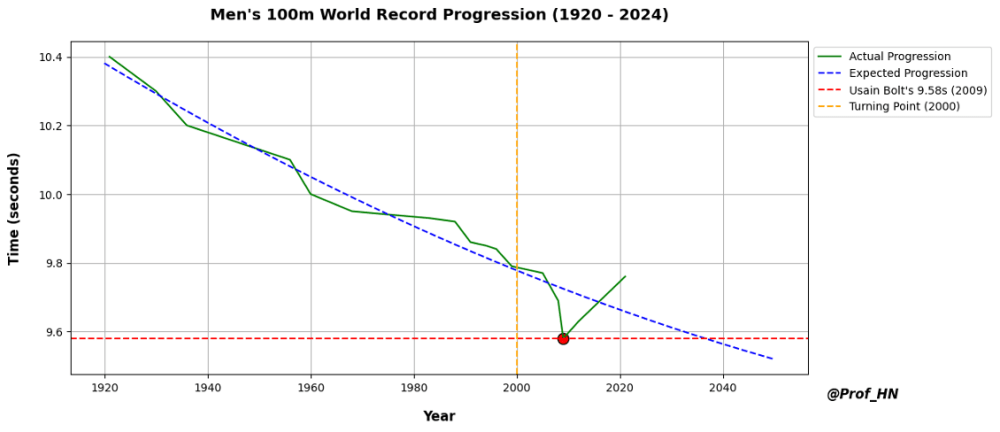Sports photography helps us understand the gap between Usain Bolt and his competitors as they cross the finish line. (Gallo)
In elite sports, the difference between victory, defeat or position often boils down to milliseconds. In light of the popularity of competitive sporting events, it’s worth exploring how these tiny fractions of time can determine gold or bronze, shape the future of sports performance and redefine our understanding of athletic excellence.
For example, Usain Bolt’s iconic 100m record race at the 2009 World Championships, where he set a world record of 9.58 seconds. The gap between Bolt and second-place Tyson Gay was a mere 0.13 seconds (130 milliseconds), with Asafa Powell trailing at 9.84 seconds, 0.26 seconds (260 milliseconds) behind Bolt. Incredibly, the difference between Bolt and the last-place runner was just 0.76 seconds (760 milliseconds) — under one second.
This tiny margin illustrates how closely contested these races are, where milliseconds separate champions from the rest. Further, the most recent 100m races were separated by a mere 0.02 and 0.12 seconds between the first and last-place runners, respectively.
To put this into perspective, consider listening to a sound with a 0.76 second interval. That brief pause mirrors the gap between Bolt and his competitors as they crossed the finish line. Such minuscule differences highlight the razor-thin margins that define elite competition, where literally every moment counts.
These athletes train for years to compete in a race that lasts under 10 seconds — and fail to get gold because they were milliseconds slower than those ahead of them. How can this ever be comprehensible?
Perhaps not comprehensible but it’s certainly quantifiable. Examining the progression of the men’s 100m world record from 1920 to the present reveals intriguing insights. By analysing historical data and applying regression analysis, we can see that the expected record for 2040 should be about 9.58 seconds. But Bolt’s achievement in 2009 was 30 years ahead of its time, demonstrating the extraordinary nature of his performance (as well as the case that he may very well be an outlier). This prompts us to consider how athletes are pushing the boundaries of what’s possible.

Similarly, in the women’s 100m, the record has improved by three seconds over the past century, while the men’s record has only advanced by one second. This disparity demonstrates the remarkable advancements in women’s athletics and the potential for future breakthroughs across genders.
Another example of milliseconds making a difference is in the 800m freestyle swimming records. Here, too, we’ve witnessed significant improvements over the years, driven by athletes’ relentless pursuit of excellence. Records are meant to be broken and athletes continue to push the envelope, performing at levels once thought unattainable.
Innovation, technology and nutrition are contributing to these advancements. Precision and accuracy in training and performance have reached unprecedented levels. Yet, the most critical factor driving this evolution is the increasing competitiveness of the sporting landscape.
Visualise the metaphor of a funnel, where countless athletes aspire to play sports at various levels, from grassroots participation to elite representation. Only a select few emerge from this funnel to become elite athletes or national representatives. This intense competition fuels the drive for excellence and pushes athletes to go beyond their limits.
A parallel can be drawn with Formula One racing, where split-second decisions and precision pit stops can make or break a race. In this high-stakes environment, even a one second delay can significantly affect a driver’s position and overall race outcome. The same principle applies across various sports, emphasising the profound effect of milliseconds.
From a batting perspective, both cricket and baseball provide compelling examples. When a bowler delivers a ball at 150km/h (about 41.67m a second), a batter has roughly under half a second to react. This brief window of time is crucial for making a selection decision and executing the shot. It highlights the importance of quick reflexes, anticipatory skills and mental agility in sports, where every split-second decision can determine the outcome. Basically, blink and you’ll miss.
As we look to the future of sports performance, it’s clear that the quest for speed, precision and excellence will only intensify. Last year, the Paris 2024 Olympics and Paralympics offered a platform to witness these advancements firsthand, as athletes from around the world competed at the highest level. In this arena, milliseconds matter more than ever, shaping the destinies of athletes and leaving an indelible mark on sport.
The power of milliseconds in elite sports cannot be overstated. Whether on the track, in the pool or on the field, these fleeting moments define the difference between greatness and mediocrity. Let us celebrate the athletes who embody this pursuit of excellence, pushing the boundaries of human potential and redefining what’s possible in the world of sports.
Habib Noorbhai is a professor of Health and Sports Science at the University of Johannesburg. @Prof_HN and https://www.habibnoorbhai.com.